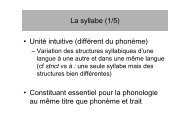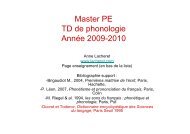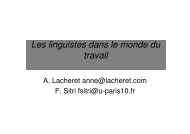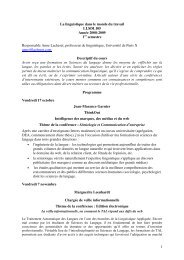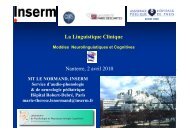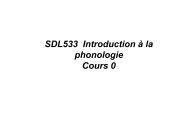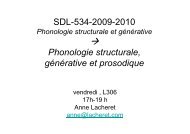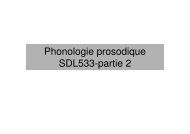You also want an ePaper? Increase the reach of your titles
YUMPU automatically turns print PDFs into web optimized ePapers that Google loves.
For a story to be real to us, Stevenson argues, the character must fade away, must be a<br />
placeholder, so that we are able to insert ourselves in the story; and what we glean<br />
from it is a form of self-understanding. The more the character is completely<br />
subsumed to the plot, the more compelling we find the story. I might agree with<br />
Stevenson if I thought that a character can have only one voice; but in fact I don’t<br />
think so. In the next section, I explain why I have come to believe that there is always<br />
more to a fictional or dramatic character that its role in a plot; and the result of the<br />
analysis will also explain my view that the character and its voice in a play or novel is<br />
in the end chordal and polyphonal.<br />
II.<br />
Is there more to Marlowe’s Doctor Faustus or to Shakespeare’s Othello than<br />
what that character specifically does in the play that bears his name? Can characters in<br />
a play or novel can be referred to, apart from their role in the plot of the novel? I<br />
would like to answer these questions in the affirmative; and there are several<br />
directions in which to take the answer. First, as Doctor Faustus is the result of the<br />
composition of two or more historical characters named Faustus who showed up in<br />
German towns in the late Middle Ages and won renown and mistrust for themselves<br />
on account of their special powers, so the figure of Othello may be based on historical<br />
precedent. This is a question for the historian and the textual scholar, who can thus<br />
supply ‘extra’ content for the figure of Othello. As Aristotle observes, when a<br />
historian treats an historical figure, he tries to fill in as much detail as possible, to<br />
recreate that figure in its concrete particularity, but a poet is more interested in its<br />
universal features. Still, the dramatic treatment of a once-real person can range<br />
between the detailed presentation of Shaw’s Saint Joan, in which the author makes use<br />
of a trial transcript, and the mythic presentation of Homer’s Agamemnon.<br />
Second, Othello is a type; in fact, he personifies two important types. On the<br />
one hand, he is the cultural Other in a Venice of the imagination that is in certain<br />
respects open (it is a seaport) and in certain respects closed (it is an aristocratic<br />
oligarchy). In the role of Other, he shares our consideration with Shylock, and with<br />
Portia as long as she is dressed like a lawyer. On the other hand, he is the Jealous<br />
Husband, driven mad by his unfounded fears, and so shares our imagination with<br />
Leontes, King of Sicilia in The Winter’s Tale. In thinking about both types, since they<br />
are universals, we may also supply ourselves, for we all have first, second and third<br />
person experience of otherness and of jealousy—topics that, by the way, invoke<br />
privacy, secrecy, exclusiveness and excludedness, the bounds and displacements of<br />
mutuality. We can supply ‘extra’ content to the figure of Othello from our own<br />
experience, which is also the basis on which we understand the tragedy, the source of<br />
its pity and fear.<br />
Moreover, these types brought to life in a great work of art go on to live another life,<br />
as Martine de Gaudemar shows so well in her development of the notion of<br />
personages, not just in the imagination of an individual, but as a public feature of our<br />
social world. Thus we all know what it means to call someone an Iago, or to compare<br />
a public figure to Othello. Such personages, neither historical figures nor abstract<br />
concepts, walk among us provided with a story and a character that is a pattern of<br />
strengths and weaknesses; they are known objectively insofar as they constitute part of<br />
a shared cultural heritage, they have real effects on our lives, and they attract other,<br />
further stories.<br />
62



